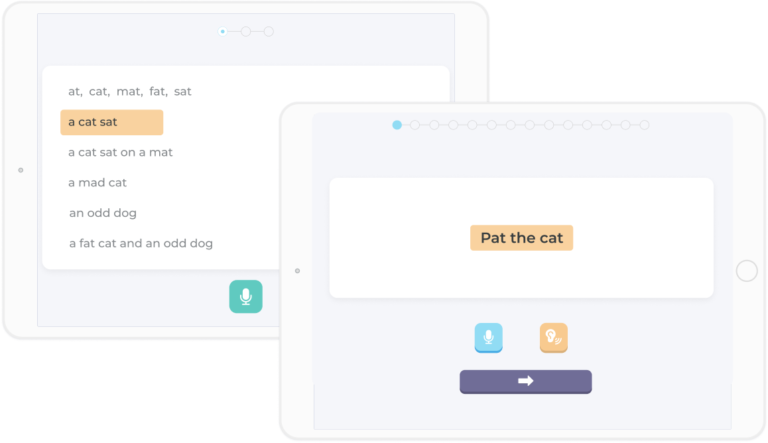Decodable texts are a key tool in reading instruction for struggling readers and dyslexic children
Reading is a fundamental skill that opens doors to knowledge, imagination, and opportunity. As we know, for many children, learning to read is a daunting challenge. In the GoLexic reading programme, children strengthen their reading skills using decodable texts. But what exactly do these do differently than the texts usually used at school?
Decodable texts have emerged as a valuable resource in literacy instruction. They offering a structured approach that supports the learning needs of struggling readers. Let’s take a closer look at what they have to offer!

Understanding Decodable Texts
Decodable texts are carefully crafted reading materials designed to align with the phonics skills that are taught in early reading instruction.
Traditional texts or storybooks often contain irregularly spelled words and complex language structures. They focus on story and meaning.
Decodable texts, on the other hand, consist primarily of words that can be sounded out using the letter-sound correspondences that students have already learned. These texts typically start with simple, one-syllable words and gradually increase in complexity as students develop their decoding skills.
Decodable texts provide opportunities for students to apply their knowledge of phonics in a meaningful context. This in turn reinforces their understanding of sound-letter relationships and helps build fluency in reading.
This means that word selection takes precedence over meaning. But as we know, struggling readers spend so much effort decoding texts, that comprehension is often secondary for them. At least in the early stages of learning to read. For these children, the priority is to improve their decoding skills so that reading can become less strenuous. When that is doable, they can focus more naturally on the meaning of words: reading comprehension.
How do Decodable Texts aid reading Instruction?
Decodable texts play a crucial role in systematic phonics instruction, a research-based approach to teaching reading. They provide students with texts that closely match their phonics skills. This reinforces learning and offers meaningful opportunities for practice. Here is how they help build fluency and proficiency in reading:
- Systematic Phonics Instruction: Decodable texts are an integral component of systematic phonics instruction. They are part of a research-based approach to teaching reading that emphasizes the systematic and explicit teaching of phonemic awareness and phonics skills. By providing students with texts that align closely with the phonics skills they are learning, decodable texts offer opportunities for practice and reinforcement. They help to solidify students’ understanding of the alphabetic principle.
- Building Confidence and Motivation: For struggling readers, the process of learning to read can be frustrating and disheartening. Decodable texts offer a sense of achievement and progress, as children are able to successfully decode and read the words on the page. This success boosts their confidence and motivation, making them more likely to persist in their reading efforts.
- Supporting Comprehension Skills: While the primary focus of decodable texts is on decoding skills, they also play a role in supporting the development of comprehension skills. Decodable texts provides students with texts that are carefully matched to their current level of phonics knowledge. In doing so, they ensure that students are not overwhelmed by unfamiliar words, allowing them to focus more attention on understanding the meaning of the text.
- Individualized Instruction: One of the key strengths of decodable texts is their ability to be tailored to the specific needs of individual students. This means we can build or select decodable texts that correspond to the phonics skills students are currently working on. Doing so provides targeted support and scaffolding to help students progress at their own pace.
Importance of Decodable Texts
Decodable texts hold significant importance in literacy education, particularly for dyslexic children. These texts make reading more accessible by breaking down the reading process into manageable steps, promoting equity and ensuring that all students have access to evidence-based practices that support their learning needs.
- Evidence-Based Practice: The use of decodable texts is supported by a substantial body of research demonstrating their effectiveness in promoting early reading skills, particularly for struggling readers and dyslexic children. By incorporating decodable texts into reading instruction, parents can be confident that they are using evidence-based practices to support student learning.
- Accessibility: Decodable texts make reading more accessible for struggling readers and dyslexic children by breaking down the reading process into manageable steps. By focusing on phonics skills, these texts provide a structured pathway to reading success. This helps to level the playing field for students who may struggle with more traditional approaches to reading instruction.
- Equity: Access to high-quality literacy instruction is essential for all students, regardless of their background or learning needs. Decodable texts help to promote equity in literacy education by providing a scaffolded approach to reading instruction that supports the diverse needs of students in inclusive classrooms.
What is the difference between texts in simple-language and decodable texts?
Easy-to-read texts and decodable texts serve distinct purposes in literacy instruction. They also target different aspects of reading development. Here’s a breakdown of the key differences between the two:
Decodable Texts:
- Focus on Phonics: Decodable texts are specifically designed to support phonics instruction. They use words that can be decoded using the letter-sound correspondences students have learned. These texts prioritize phonetic regularity, with the majority of words adhering to phonics rules.
- Structured Progression: Decodable texts typically follow a structured progression. They start with simple, one-syllable words and gradually increasing in complexity as students acquire new phonics skills. This scaffolding helps students build fluency and confidence in their decoding abilities.
- Targeted Support: Decodable texts are particularly beneficial for children who struggle with phonemic awareness and decoding skills. These texts provide targeted support and practice opportunities, which help students develop essential foundational skills for reading.
Easy-to-Read or simple-language Texts:
- Highly Predictable Language: Simple-language texts often feature highly predictable language patterns, repetitive phrases, and familiar vocabulary. This is what make these texts accessible to emergent readers. It supports comprehension by reducing cognitive load.
- Varied Vocabulary: While Simple-language texts may contain some phonetically regular words, they also include high-frequency sight words and vocabulary that does not strictly adhere to phonics rules. This allows for exposure to a wider range of vocabulary and language structures.
- Emphasis on Comprehension: Simple-language texts prioritize comprehension over decoding, aiming to engage readers and promote understanding of the text’s meaning. While decoding skills are still important, the focus of simple-language texts is to make connections between the text and prior knowledge. The goal is to help the reader predict outcomes, and inferring meaning.
Key Takeaways:
- Decodable texts are a valuable tool in reading instruction, particularly for struggling readers and dyslexic children.
- These texts help to build essential reading skills and confidence in learners by providing systematic and scaffolded support for phonics instruction. This, ultimately, paves the way for reading success.
- Decodable texts are an essential component of effective reading programs. They ensuring that all students have the opportunity to become proficient readers.

